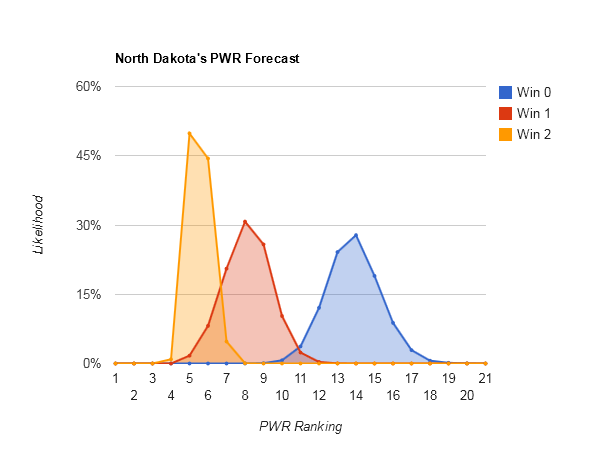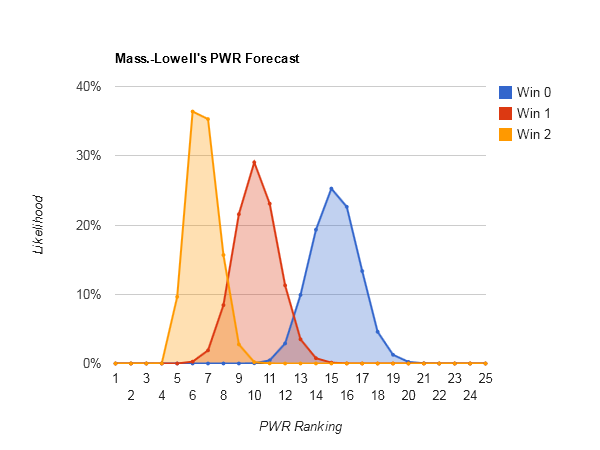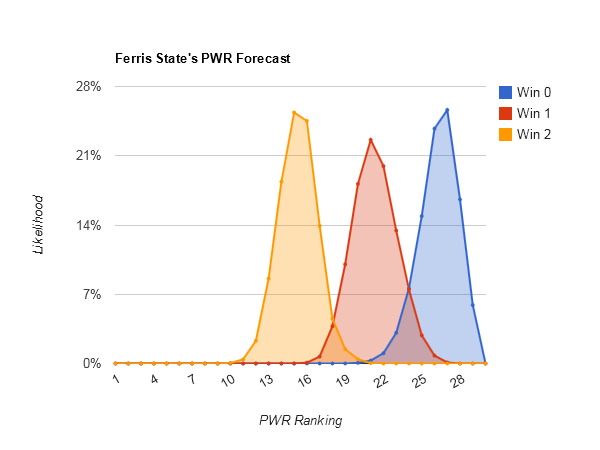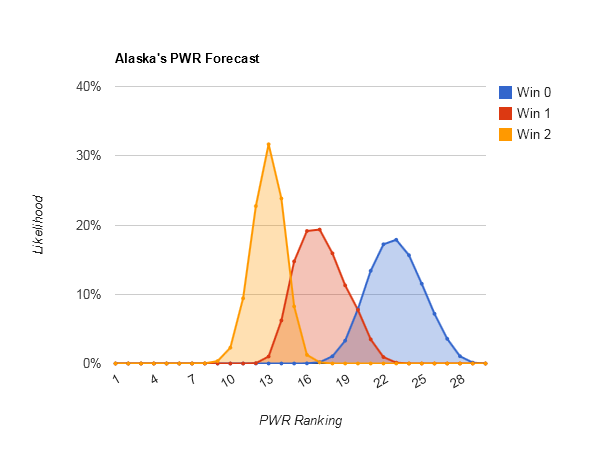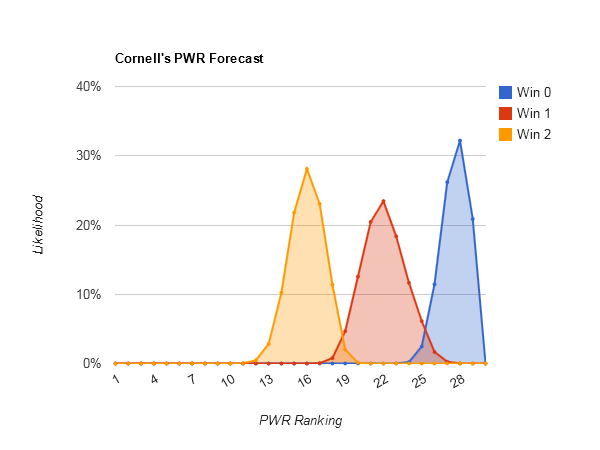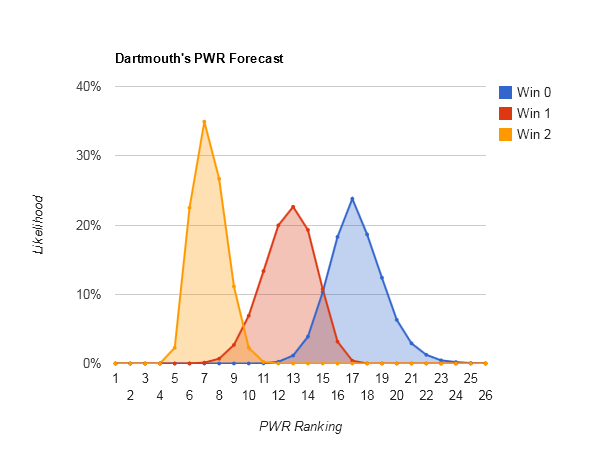#6 UND is still perched somewhat precariously high in the Pairwise Rankings (PWR), though can continue to stay there if they keep winning.
Follow-up on last week’s predictions
Let’s also take a look back at last week’s A first look at NCAA hockey PairWise Rankings (PWR). I observed (and the outcomes were) that:
- #4 Minnesota was secure in its PWR and that anything short of being swept would be unlikely to result in a drop. (Minnesota took 3 points and climbed to #2.)
- #7 UND was on a bit more of a cliff and had the potential to fall substantially if swept. (UND took 1 point and climbed to #6. Though well within the predicted range for being between 0 and 1 wins, UND came out near the top of the range because of an unlikely sweep of Denver by St. Cloud State, as further explained in this forum post.)
- #3 Quinnipiac was the real deal and would be well protected against sharp downward movement. (Despite not playing, Quinnipiac climbed to #1.)
- #6 Boston University was in an artificially high ranking and doomed to fall a bit when some inevitable losses came in. (BU fell to #13 after a pair of tough losses to Northeastern and Mass. Lowell.)
All-in-all, the predictions were pretty good. A little more information could have helped readers anticipate UND’s additional strength if St. Cloud St. swept, so I’ll try to include more of that sort of information. Otherwise, readers knew in advance of Minnesota’s and Quinnipiac’s strength and Boston University’s hidden weakness.
North Dakota this week
Currently ranked #6, UND continues to have significantly more downside than upside. A sweep is most likely to result in a rise of only one position (though staying #6 is also quite likely), whereas getting swept could result in a fall of up to around 10 positions.
Games that most affect UND’s PWR
| Outcome | Average effect on UND’s PWR |
|---|---|
| UND over St. Cloud (2 of 2) | 8.33 |
| UND over St. Cloud (1 of 2) | 5.73 |
| Holy Cross over Bentley (2 of 2) | 1.03 |
| Holy Cross over Bentley (1 of 2) | 0.80 |
| Clarkson over Dartmouth | 0.63 |
| Alaska Anchorage over Wisconsin (2 of 2) | 0.58 |
| Northeastern over Mass.-Lowell (2 of 2) | 0.54 |
| Minnesota over MSU-Mankato (2 of 2) | 0.52 |
| Cornell over Yale | 0.52 |
| St. Lawrence over Dartmouth | 0.50 |
UND comparisons most likely to flip
To figure out why those games matters takes some diving into North Dakota’s PWR comparisons.
Upside potential
- Cornell and/or Colgate wins over Yale could help UND take the comparison with Yale as TUC comes into play when Yale reaches 10 games vs. TUCs.
Downside potential
- A Bentley win over Holy Cross could knock Holy Cross out of consideration. This would considerably harm UND’s winning percentage vs. TUCs.
- A Clarkson win over Dartmouth would be enough to give Dartmouth the edge over UND’s current RPI. A St. Lawrence win over Dartmouth would have a slightly smaller effect.
- A pair of Wisconsin wins over Alaska Anchorage could be enough to take RPI and COP, and thus the comparison with UND.
- A Mass.-Lowell win over Northeastern would give Mass.-Lowell the edge over UND’s current RPI and the comparison with UND.
On the cliff
The two teams with the most lopsided downside vs. upside potential this week are Mass.-Lowell and North Dakota.
| Team | Current PWR | Highest PWR with >1% chance |
Lowest PWR with >1% chance |
|---|---|---|---|
| Mass.-Lowell | 7 | 5 | 19 |
| North Dakota | 6 | 5 | 17 |
Having already beat to death why UND has little upside potential but high downside potential this week, let’s take a quick look at Mass.Lowell.
First, looking at Mass.-Lowell’s PWR comparisons, notice that they haven’t yet played enough teams under consideration for the TUC criterion to come into play. Northeastern, their only opponent this weekend, also isn’t a TUC so only some movement along the TUC line would bring this into play (and none is obvious).
Second, notice that of the first 7 comparisons Mass.-Lowell wins (Miami through St. Cloud St), 6 could easily be flipped to losses via RPI (the RPIs are within .01 and flipping them would flip the comparison).
Finally, the only obvious upside potential for Mass.-Lowell is taking the comparison with North Dakota if UND stumbles.
Other superlatives
But those aren’t the biggest potential movers of the weekend (again, only measuring outcomes with over a 1% likelihood).
Teams in the high teens, low twenties seem poised to make the biggest moves in either direction. #21 Ferris St. could fall between #12 and #30, #18 Alaska between #10 and #28, and #22 Cornell between #13 and #30.
But #9 Dartmouth has the largest one way (downside) potential, with the possibility of falling up to 13 spots to #22 if everything goes wrong.
Methodology
Each forecast is based on at least one million monte carlo simulations of the games in the described period. For each simulation, the PairWise Ranking (PWR) is calculated and the results tallied. The probabilities presented in the forecasts are the share of simulations in which a particular outcome occurred.
The outcome of each game in each simulation is determined by random draw, with the probability of victory for each team set by their relative KRACH ratings. So, if the simulation set included a contest between team A with KRACH 300 and team B with KRACH 100, team A will win the game in very close to 75% of the simulations. I don’t simulate ties or home ice advantage.
Resources
- Current PWR Rankings (SiouxSports.com)
- Current RPI Rankings (SiouxSports.com)
- CHN PWR Rankings (CollegeHockeyNews.com)
- TBRW build your own rankings (slack.net)
- Explanation of how PWR mimics NCAA tournament selection (CollegeHockeyNews.com)
